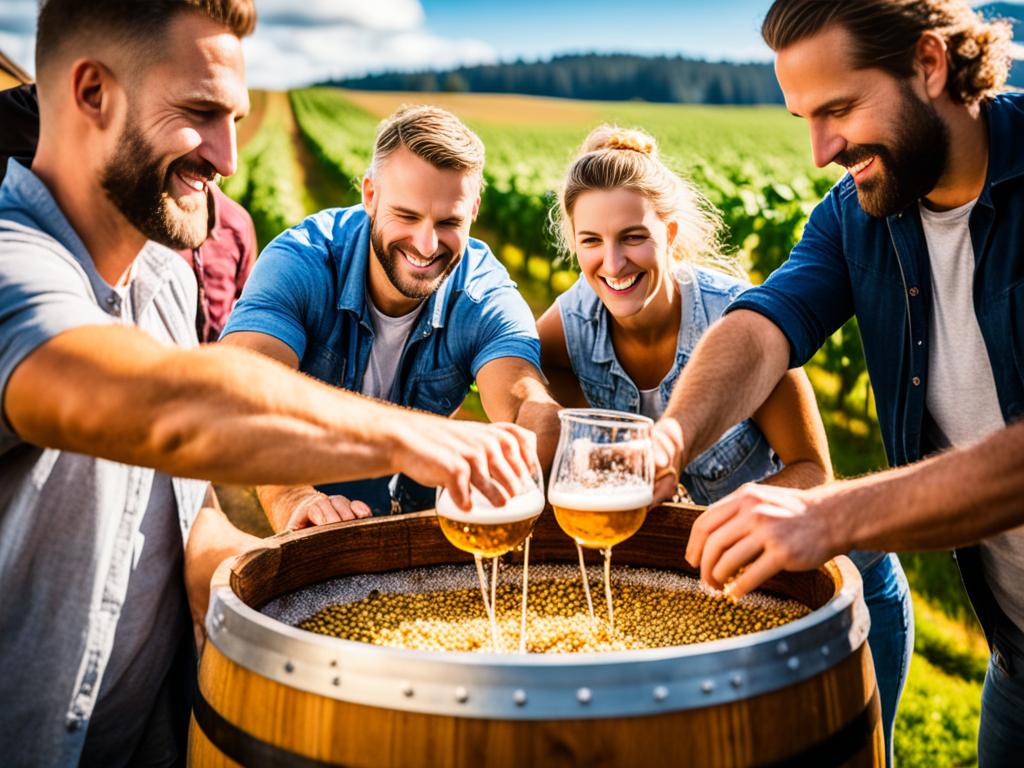Welcome to a fascinating journey through time as we uncover the captivating history of beer. From its ancient origins to the modern innovations of today, beer has a rich and diverse story that spans centuries.
Beer, a beloved beverage enjoyed by many, has played an integral role in human culture and society. It has been a part of our celebrations, our traditions, and our daily lives. But how did it all begin? Join us as we explore the intriguing origins and evolution of beer.
Key Takeaways:
- Beer has a long and storied history, dating back to ancient civilizations.
- The Middle Ages saw the influence of monasteries in the brewing industry.
- The Industrial Revolution revolutionized beer production and availability.
- Prohibition had a significant impact on the beer industry in the United States.
- Understanding the history of beer helps us appreciate its cultural significance and impact on society.
Ancient Brews and Their Makers
In the fascinating world of beer history, it is vital to understand the origins of this beloved beverage. Our journey through time takes us back to ancient civilizations that first embraced the art of brewing. From the Sumerians of Mesopotamia to the Egyptians and beyond, these early societies laid the foundation for what would eventually become a global phenomenon.
Ancient brews were more than just a drink; they held significant cultural and religious importance. Brewed using traditional techniques and simple ingredients, these early beers connected people, celebrated special occasions, and played integral roles in religious rituals. The art of brewing, passed down through generations, became a fundamental part of these ancient cultures’ fabric.
The Sumerians, considered the oldest brewers in history, left behind cuneiform tablets that document their brewing processes. They used barley as the primary grain, fermenting it with water and then adding various flavorings such as dates or honey. The resulting beverage was consumed through reed straws and even offered as offerings to deities.
Moving across ancient Egypt, beer was a staple in the daily lives of both royals and commoners. The Egyptians elevated beer production to an industrial scale, utilizing large breweries and employing professional brewers. Their techniques included malting barley, fermenting with specific strains of yeast, and using flavorings like dates or spices. Beer in Ancient Egypt was so valued that it was even used as currency for wages, offering an intriguing glimpse into its significance.
The Brewing Process in Ancient Civilizations
To fully appreciate the ancient brews, it’s essential to understand the brewing techniques employed by these early civilizations. While the precise process varied across regions and time, some common steps were followed.
- Malting: Barley or other grains were soaked in water and then dried, triggering the germination process.
- Mashing: The malted grain was mixed with water and heated to extract sugars, converting them to fermentable form. This sweet liquid, known as wort, served as the basis for fermentation.
- Fermentation: The wort was inoculated with yeast, which consumed the sugars and produced alcohol and carbon dioxide. Fermentation took place in vessels, often made of clay or ceramic.
- Aging: Some ancient brews were aged to allow flavors to develop and mellow over time.
- Additional flavorings: Depending on the region, brewers added various ingredients like herbs, fruits, and spices to enhance the taste of the beer.
These techniques, perfected by the ancient brewmasters, set the stage for the rich diversity of beer we enjoy today. As we explore the history of beer, it becomes evident that the thirst for this fermented elixir has transcended centuries and cultures, shaping our shared human experience.
In the next section, we will uncover the role of monasteries in the Middle Ages and their significant contributions to the brewing process.
The Middle Ages: Monasteries and the Spread of Brewing
During the Middle Ages, beer took on a new form as it became intertwined with the activities of monasteries across Europe. Monasteries played a crucial role in the development and dissemination of beer in the Middle Ages. Medieval monks not only brewed beer for their sustenance but also possessed extensive knowledge of brewing techniques and ingredients. Their expertise transformed the beer industry, elevating brewing to a refined art form.
Monastic brewing was driven by both practical and spiritual motives. Monks brewed beer as a means of nourishment, as it was a safer and more reliable alternative to water, which was often contaminated. The brewing process involved boiling, which killed harmful bacteria, making beer a healthier choice. In addition to fulfilling their own needs, monks brewed beer in the Middle Ages to share with the local communities. This practice of hospitality and generosity helped establish and strengthen relationships between the monasteries and the surrounding towns and villages.
The monastic tradition of brewing soon spread throughout Europe. Monasteries became centers of brewing excellence, producing a variety of brews that showcased the unique skills and techniques of each monastery. Different styles of beer emerged during this period, each reflecting the local ingredients and preferences of the brewing monks. From rich and malty ales to refreshing and crisp lagers, the monastic breweries catered to a wide range of tastes.
Monks were meticulous in their approach to brewing, paying careful attention to the quality of ingredients, the brewing process, and the storage of beer. They crafted their recipes with precision, using locally sourced grains, hops, and herbs to create distinctive flavors. Monasteries also pioneered techniques such as barrel aging, allowing beer to develop complex flavors over time.
“The brewing methods developed by the medieval monks laid the foundation for modern brewing practices. Their dedication to quality and innovation continues to inspire brewers to this day.” – Dr. Johann Braun, Brewmaster and Historian
To honor the rich brewing heritage of the Middle Ages, some modern breweries have recreated ancient monastic recipes, embracing traditional techniques and ingredients. These beers provide a taste of history, allowing beer enthusiasts to experience the flavors enjoyed by medieval monks and their communities.
| Styles of Beer in the Middle Ages | Description |
|---|---|
| Ale | A top-fermented beer with a rich, malty flavor and fruity esters. |
| Lager | A bottom-fermented beer known for its crispness and smooth character. |
| Witbier | A Belgian-style beer brewed with wheat, often spiced with coriander and orange peel. |
| Trappist Beer | A beer brewed within the walls of a Trappist monastery, known for its complexity and high quality. |
The monastic breweries of the Middle Ages not only shaped the beer industry but also contributed to the preservation of brewing knowledge. Monasteries were the keepers of recipes, techniques, and traditional brewing wisdom, passed down through generations of monks. Without their dedication and expertise, the art of brewing may have been lost to history.
In the next section, we will explore the impact of the Industrial Revolution on beer production and how it transformed the brewing industry.
The Rise of Monastic Breweries
As the popularity of monastic beer grew, many monasteries established their own breweries to meet the demand. These monastic breweries became important economic centers, providing a sustainable source of income for the monastic communities. The sale of beer allowed monasteries to fund their daily operations, support charitable works, and contribute to the development of their local economies.
Industrial Revolution: The Transformation of Beer Production
The Industrial Revolution had a profound impact on the beer industry, leading to significant advancements in the way beer was produced and consumed. This era, characterized by technological innovations and societal changes, revolutionized the brewing process and paved the way for the modern beer industry we know today.
During the Industrial Revolution, beer production underwent a dramatic transformation. The invention of new brewing equipment, such as the steam-powered brew kettle and the hydrometer, revolutionized the efficiency and consistency of the brewing process. These technological advancements allowed brewers to produce larger quantities of beer more quickly, enabling the rise of commercial breweries.
Commercial breweries, powered by steam engines and innovative machinery, emerged as key players in the beer industry during this time. These breweries had the capacity to produce beer on a much larger scale, resulting in increased variety and availability of beer. With improved transportation networks and the development of bottling techniques, beer could now reach a wider market, transcending local and regional boundaries.
The industrialization of beer production not only led to increased quantity, but also to the standardization of beer styles. With the ability to replicate recipes and control the brewing process more precisely, brewers could create consistent flavors and ensure a reliable product. This allowed consumers to develop preferences for specific beer styles, contributing to the diversification of the beer market.
The Impact of Industrialization on Beer Production:
“The Industrial Revolution marked a turning point in the history of beer production. It led to technological advancements that revolutionized brewing techniques, resulting in increased production capacity and the availability of a wider variety of beers.”
The image below provides a visual representation of the impact of the Industrial Revolution on beer production:
| Key Advancements | Impact on Beer Production |
|---|---|
| Invention of brewing equipment | Improved efficiency and consistency in the brewing process |
| Rise of commercial breweries | Increased production capacity and wider availability of beer |
| Standardization of beer styles | Consistent flavors and reliable products |
| Improved transportation and bottling techniques | Expanded market reach beyond local and regional boundaries |
The Industrial Revolution transformed beer production, making it more efficient, standardized, and accessible. These advancements set the stage for the beer industry’s future growth and paved the way for the innovations and developments we continue to witness in the world of brewing today.
Prohibition and Beer’s Fight for Survival
Prohibition, a period in American history from 1920 to 1933, had a profound impact on the beer industry. During this time, the production, sale, and consumption of alcoholic beverages, including beer, were temporarily banned. This government-imposed ban aimed to reduce crime, corruption, and social issues associated with alcohol consumption.
For the beer industry, Prohibition brought about significant challenges. Breweries were forced to shut down or adapt their operations to produce non-alcoholic alternatives. Many breweries struggled to survive, and thousands of jobs were lost. The beer industry, once thriving, suddenly faced an uncertain future.
However, brewers were determined to find ways to continue their craft in the face of adversity. Some breweries shifted their focus to producing non-alcoholic beverages such as soft drinks and malt products. Others resorted to manufacturing “near beer,” a low-alcohol beer that contained less than 0.5% alcohol by volume, to fulfill the public’s demand for beer-like beverages.
“Near beer” provided some solace to beer enthusiasts during Prohibition, but it was not without its challenges. The taste lacked the full-bodied flavor of traditional beer, and the alcohol content was significantly reduced. Nevertheless, it managed to sustain some breweries and keep them afloat during this trying period.
The end of Prohibition in 1933 marked a turning point for the beer industry. Once the ban was lifted, breweries seized the opportunity to resume beer production and rebuild their businesses. However, the effects of Prohibition were lasting. The beer industry had undergone significant changes during its years of prohibition, and the landscape was forever altered.
Efforts to Rebuild and Innovate
With the re-legalization of beer, breweries had to rebuild their reputation and regain consumers’ trust. They focused on quality, consistency, and innovation to differentiate themselves in the market. New brewing techniques, ingredients, and flavor profiles emerged, leading to a resurgence of creativity within the beer industry.
Breweries also embraced marketing and branding strategies to reconnect with consumers. They emphasized the craftsmanship, tradition, and cultural significance of beer in their messaging, appealing to consumers’ appreciation for authenticity and a sense of history.
Today, the beer industry continues to thrive, showcasing a diverse array of styles and flavors. Craft breweries have gained popularity, offering unique and artisanal brews that cater to evolving consumer preferences. Beer enthusiasts can now enjoy a rich tapestry of tastes, from classic styles to experimental creations.
The Legacy of Prohibition
The impact of Prohibition on the beer industry cannot be overstated. It forced breweries to adapt, innovate, and fight for survival. While many breweries did not survive the ban, those that did emerged stronger, ready to meet the demands of a new era.
The lessons learned during Prohibition continue to shape the beer industry today. Brewers understand the importance of resilience and the need to constantly evolve to meet changing consumer preferences and regulatory landscapes. The legacy of Prohibition serves as a reminder of the challenges faced by the beer industry and the unwavering determination of brewers to overcome them.
Conclusion
In conclusion, the history of beer is a fascinating journey that showcases the remarkable evolution of this beloved beverage. From the ancient brews of civilizations past to the diverse and thriving beer industry of today, beer has remained a constant companion, shaping cultures and connecting people across the globe.
By exploring the rich tapestry of beer’s history, we gain a deeper understanding of the human ingenuity and creativity that went into its creation. From the innovative techniques of ancient brewers to the modern advancements in brewing technology, beer has always pushed the boundaries of what is possible.
Moreover, beer’s cultural significance cannot be understated. It has served as a vital part of celebrations, religious rituals, and social gatherings throughout history, bringing people together and fostering connections. Whether it’s enjoying a pint with friends at a local pub or sampling unique craft brews at a beer festival, beer has a way of creating shared experiences and forging lasting memories.
So, let us raise a glass to the incredible history of beer, a beverage that has not only survived but thrived through the ages. As we continue to explore and appreciate the diverse world of beer, may we never forget the centuries of tradition, craftsmanship, and passion that have gone into each and every pint.







